Field and Laboratory Assessment of Different Concrete Paving Materials Thermal Behavior
Abstract
:1. Introduction
2. Materials and Methods
2.1. Materials and Sample Preparation
2.2. Thermal Conductivity Measurements
2.3. Infrared Lamp Testing
2.4. Thermal Camera Recording
3. Results and Discussion
3.1. Thermal Properties of Concrete Paving Materials
3.2. Heating and Cooling Speed Measurement Results
3.3. Field Measurement Results
4. Conclusions
- There is a significant difference in the thermal properties, and behavior between different concrete paving materials and proper material selection could be essential for proper UHI mitigation;
- The dense concrete paving material had the highest thermal conductivity coefficient, highest heat absorption capacity, and slowest heating and cooling speed, compared with the other paving materials;
- The thermal characteristics and behavior of the pavers and pervious concrete were similar, therefore, the pervious concrete, due to its improved drainage properties, could present a better solution for urban areas;
- There was a significant influence on the base layer and the surrounding characteristics on the pavement thermal behavior. Therefore, future laboratory and field tests should consider these parameters when addressing the UHI effect of different materials;
- A good correlation was observed between the results of thermal conductivity measurement and the results of thermal properties measurements conducted in the field. Therefore, thermal conductivity measurement as a simple laboratory method can be used for prediction of thermal behavior of paving materials in real conditions.
Author Contributions
Funding
Institutional Review Board Statement
Informed Consent Statement
Data Availability Statement
Conflicts of Interest
References
- Carpio, M.; González, Á.; González, M.; Verichev, K. Influence of pavements on the urban heat island phenomenon: A scientific evolution analysis. Energy Build. 2020, 226, 110379. [Google Scholar] [CrossRef]
- Chen, J.; Wang, H.; Xie, P. Pavement temperature prediction: Theoretical models and critical affecting factors. Appl. Therm. Eng. 2019, 158, 113755. [Google Scholar] [CrossRef]
- Wu, H.; Sun, B.; Li, Z.; Yu, J. Characterizing thermal behaviors of various pavement materials and their thermal impacts on ambient environment. J. Clean. Prod. 2018, 172, 1358–1367. [Google Scholar] [CrossRef]
- Jiang, J.; Jin, Y.; Bao, T.; Ou, X. Sensible heat discharging from pavements with varying thermophysical properties. Sustain. Cities Soc. 2019, 45, 431–438. [Google Scholar] [CrossRef]
- Anand, J.; Sailor, D.J. Role of pavement radiative and thermal properties in reducing excess heat in cities. Sol. Energy 2021. [Google Scholar] [CrossRef]
- Chen, J.; Zhou, Z.; Wu, J.; Hou, S.; Liu, M. Field and laboratory measurement of albedo and heat transfer for pavement materials. Constr. Build. Mater. 2019, 202, 46–57. [Google Scholar] [CrossRef]
- Karlessi, T.; Santamouris, M.; Apostolakis, K.; Synnefa, A.; Livada, I. Development and testing of thermochromic coatings for buildings and urban structures. Sol. Energy 2009, 83, 538–551. [Google Scholar] [CrossRef]
- Cheng, Y.; Zhang, X.; Fang, C.; Chen, J.; Wang, Z. Discoloration mechanism, structures and recent applications of thermochromic materials via different methods: A review. J. Mater. Sci. Technol. 2018, 34, 2225–2234. [Google Scholar] [CrossRef]
- Balan, L.A.; Anupam, B.R.; Sharma, S. Thermal and mechanical performance of cool concrete pavements containing waste glass. Constr. Build. Mater. 2021, 290, 123238. [Google Scholar] [CrossRef]
- Barišić, I.; Grubeša, I.N.; Dokšanović, T.; Zvonarić, M. Influence of Clogging and Unbound Base Layer Properties on Pervious Concrete Drainage Characteristics. Materials 2020, 13, 2455. [Google Scholar] [CrossRef]
- Grubeša, I.N.; Barišić, I.; Keser, T.; Vračević, M. Wearing characteristics assessment of pervious concrete pavements. Road Mater. Pavement Des. 2019, 20, 727–739. [Google Scholar] [CrossRef]
- Grubeša, I.N.; Barišić, I.; Ducman, V.; Korat, L. Draining capability of single-sized pervious concrete. Constr. Build. Mater. 2018, 169, 252–260. [Google Scholar] [CrossRef]
- Singh, A.; Sampath, P.V.; Biligiri, K.P. A review of sustainable pervious concrete systems: Emphasis on clogging, material characterization, and environmental aspects. Constr. Build. Mater. 2020, 261, 120491. [Google Scholar] [CrossRef]
- Wu, H.; Sun, B.; Liu, Z.; Yin, J. Laboratory-simulated investigation on thermal behaviours of permeable concrete pavements. Road Mater. Pavement Des. 2017, 18, 97–108. [Google Scholar] [CrossRef]
- Chen, J.; Chu, R.; Wang, H.; Zhang, L.; Chen, X.; Du, Y. Alleviating urban heat island effect using high-conductivity permeable concrete pavement. J. Clean. Prod. 2019, 237, 117722. [Google Scholar] [CrossRef]
- Chen, J.; Wang, H.; Xie, P.; Najm, H. Analysis of thermal conductivity of porous concrete using laboratory measurements and microstructure models. Constr. Build. Mater. 2019, 218, 90–98. [Google Scholar] [CrossRef]
- Ngohpok, C.; Sata, V.; Satiennam, T.; Klungboonkrong, P.; Chindaprasirt, P. Mechanical properties, thermal conductivity, and sound absorption of pervious concrete containing recycled concrete and bottom ash aggregates. KSCE J. Civ. Eng. 2018, 22, 1369–1376. [Google Scholar] [CrossRef]
- Park, J.H.; Kim, Y.U.; Jeon, J.; Wi, S.; Chang, S.J.; Kim, S. Effect of eco-friendly pervious concrete with amorphous metallic fber on evaporative cooling performance. J. Environ. Manag. 2021, 297, 113269. [Google Scholar] [CrossRef]
- Tan, K.; Qin, Y.; Du, T.; Li, L.; Zhang, L.; Wang, J. Biochar from waste biomass as hygroscopic filler for pervious concrete to improve evaporative cooling performance. Constr. Build. Mater. 2021, 287, 123078. [Google Scholar] [CrossRef]
- Wang, J.; Meng, Q.; Tan, K.; Zhang, L.; Zhang, Y. Experimental investigation on the influence of evaporative cooling of permeable pavements on outdoor thermal environment. Build. Environ. 2018, 140, 184–193. [Google Scholar] [CrossRef]
- Qin, Y.; Hiller, J.E. Water availability near the surface dominates the evaporation of pervious concrete. Constr. Build. Mater. 2016, 111, 77–84. [Google Scholar] [CrossRef]
- Qin, Y.; He, Y.; Hiller, J.E.; Mei, G. A new water-retaining paver block for reducing runoff and cooling pavement. J. Clean. Prod. 2018, 199, 948–956. [Google Scholar] [CrossRef]
- Shimazaki, Y.; Aoki, M.; Karaki, K.; Yoshid, A. Improving outdoor human-thermal environment by optimizing the reflectance of water-retaining pavement through subjective field-based measurements. Build. Environ. 2022, 210, 108695. [Google Scholar] [CrossRef]
- Liu, Y.; Li, T.; Yu, L. Urban heat island mitigation and hydrology performance of innovative permeable pavement: A pilot-scale study. J. Clean. Prod. 2020, 244, 118938. [Google Scholar] [CrossRef]
- Ferrari, A.; Kubilay, A.; Derome, D.; Carmeliet, J. The use of permeable and reflective pavements as a potential strategy for urban heat island mitigation. Urban Clim. 2020, 31, 100534. [Google Scholar] [CrossRef]
- Senevirathne, D.M.; Jayasooriya, V.M.; Dassanayake, S.M.; Muthukumaran, S. Effects of pavement texture and colour on Urban Heat Islands: An experimental study in tropical climate. Urban Clim. 2021, 40, 101024. [Google Scholar] [CrossRef]
- Grubeša, I.N.; Barišić, I.; Bačun, B.; Juradin, S. Properties and Applicability of Pervious Concrete for Paving Flags. In Proceedings of the International Symposium on Frontiers of Road and Airport Engineering, Delft, The Netherlands, 12–14 July 2021. [Google Scholar]
- Mohajerani, A.; Bakaric, J.; Jeffrey-Bailey, T. The urban heat island effect, its causes, and mitigation, with reference to the thermal properties of asphalt concrete. J. Environ. Manag. 2017, 197, 522–538. [Google Scholar] [CrossRef]
- Kevern, J.T.; Schaefer, V.R.; Wang, K. Temperature behavior of pervious concrete systems. Transp. Res. Rec. J. Transp. Res. Board 2009, 2098, 94–101. [Google Scholar] [CrossRef]
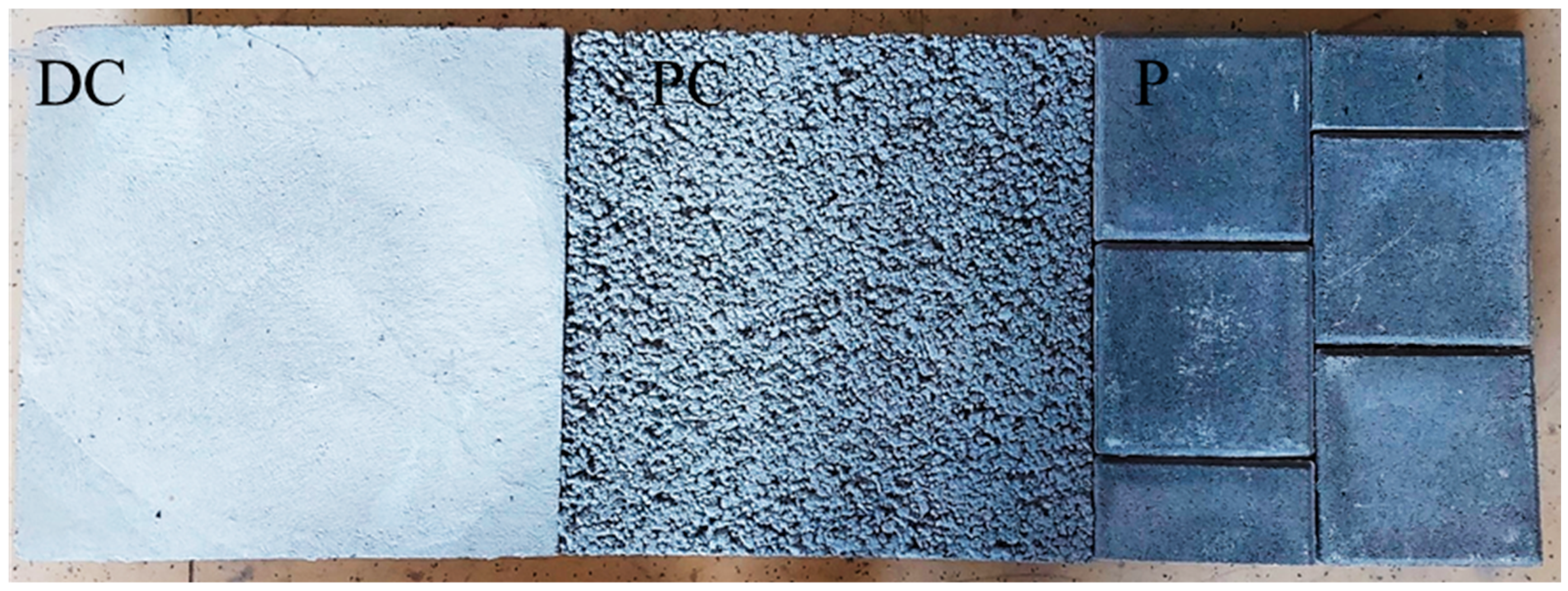
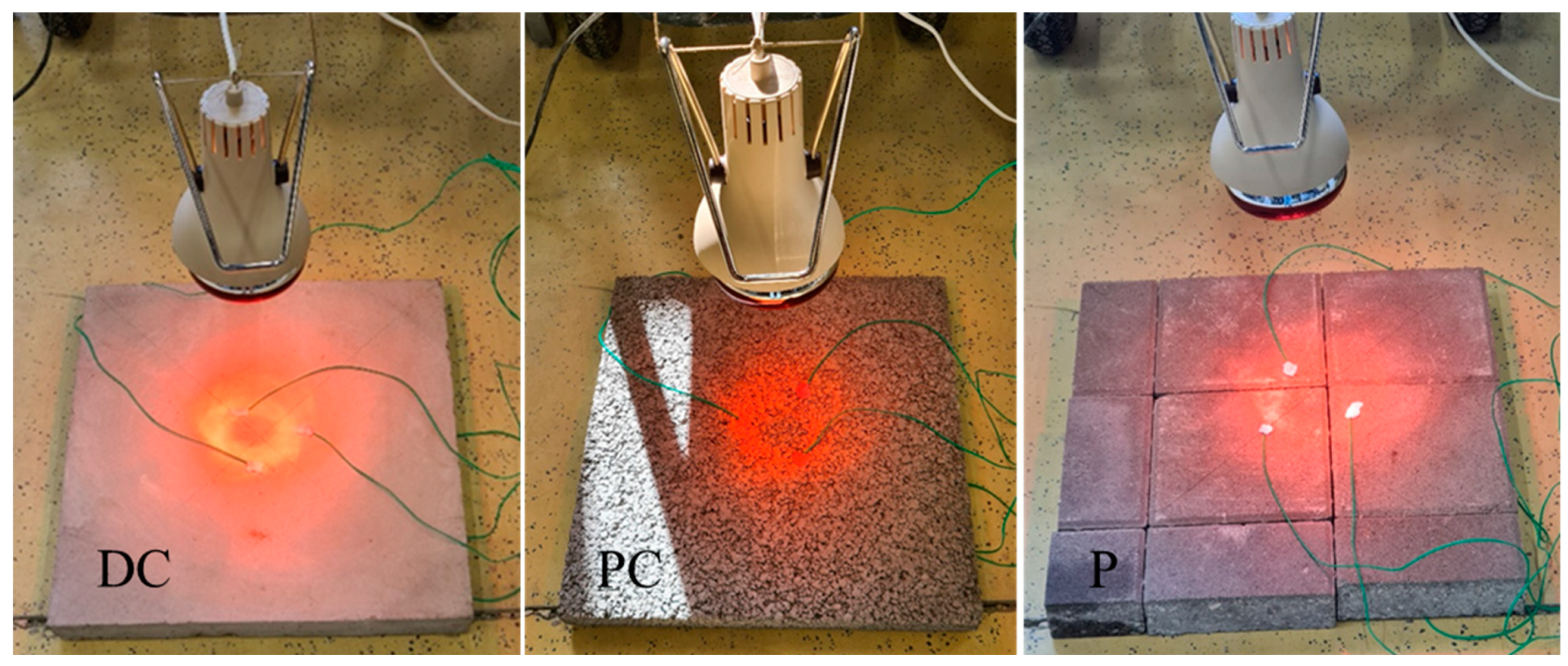
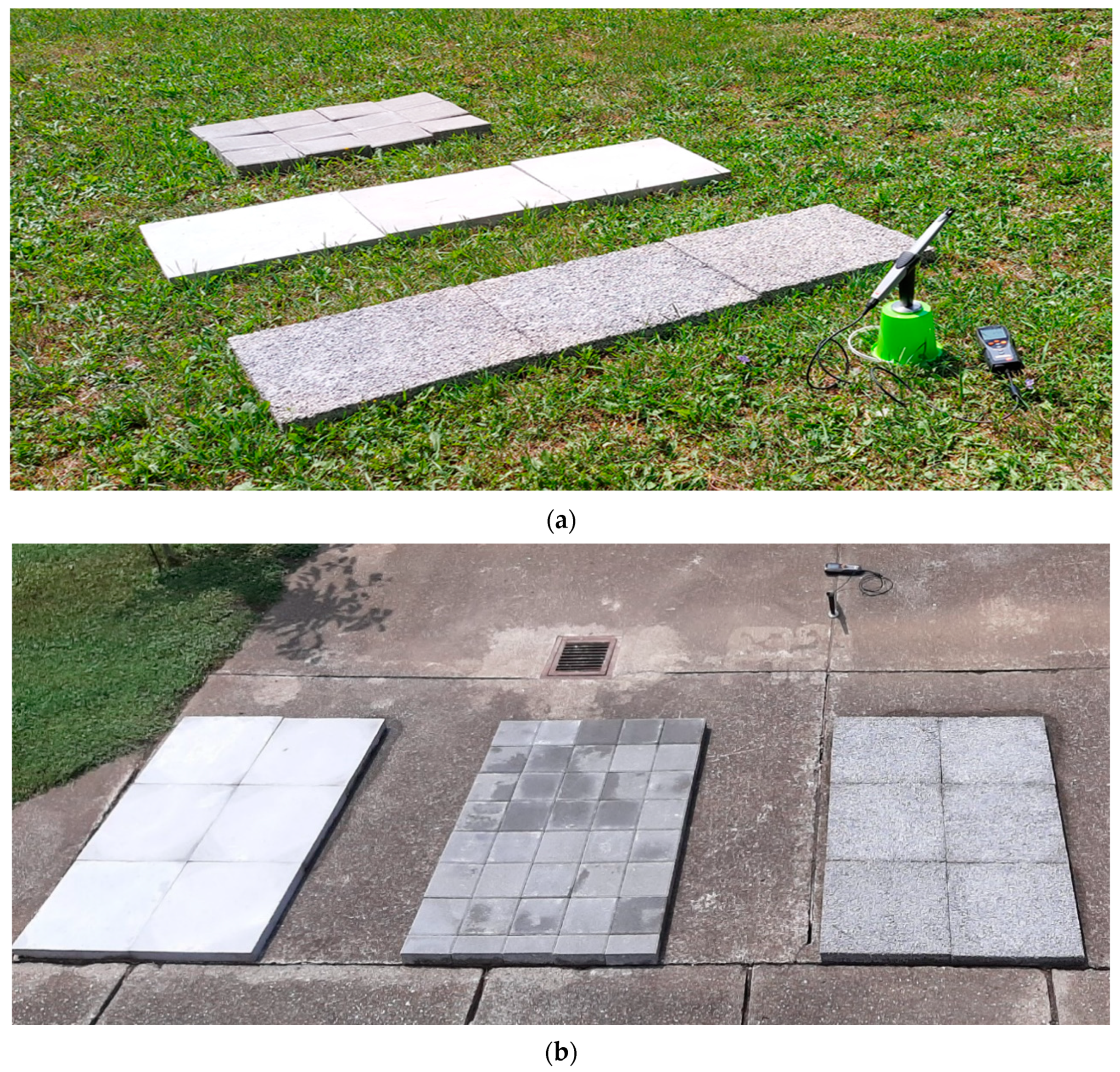

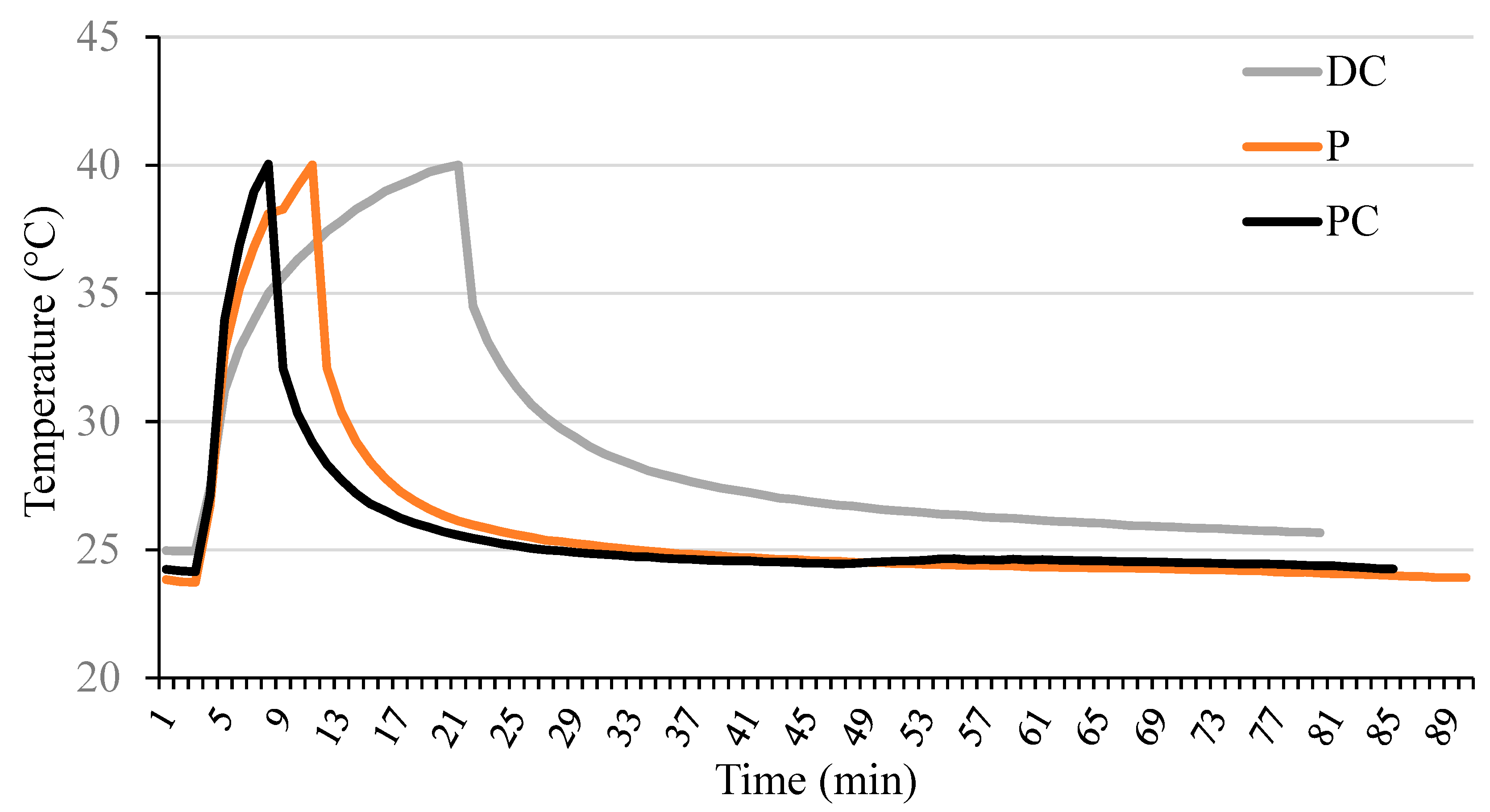
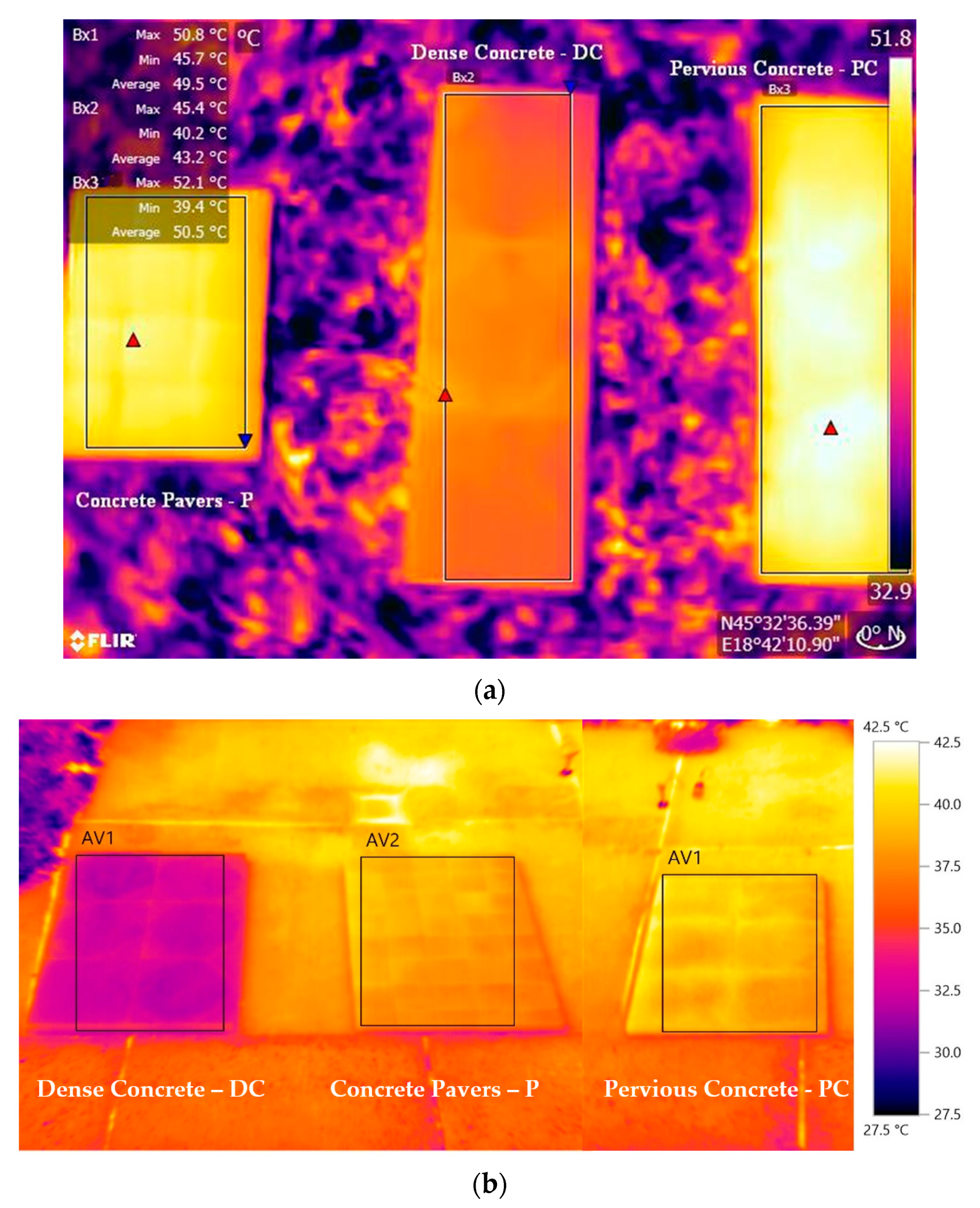
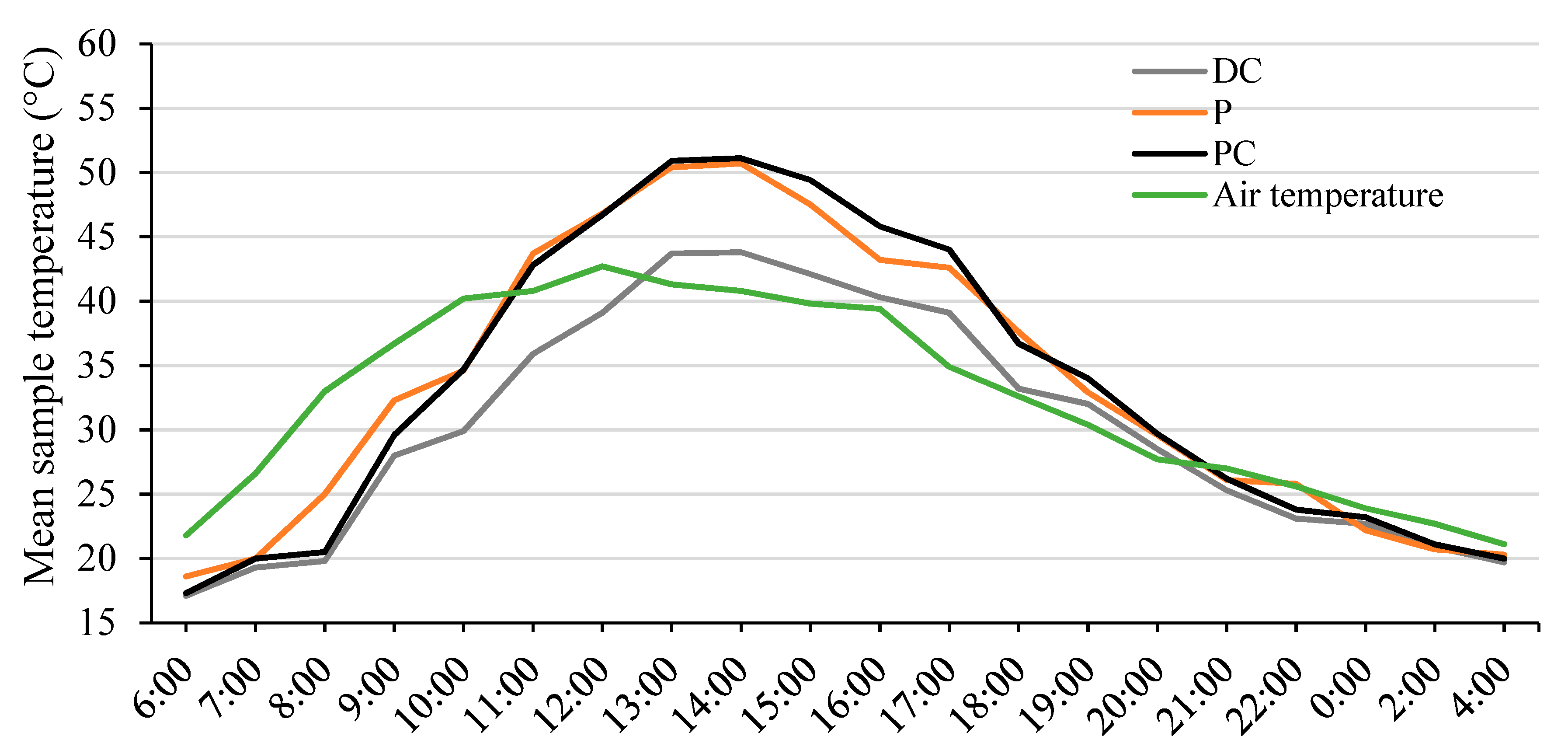
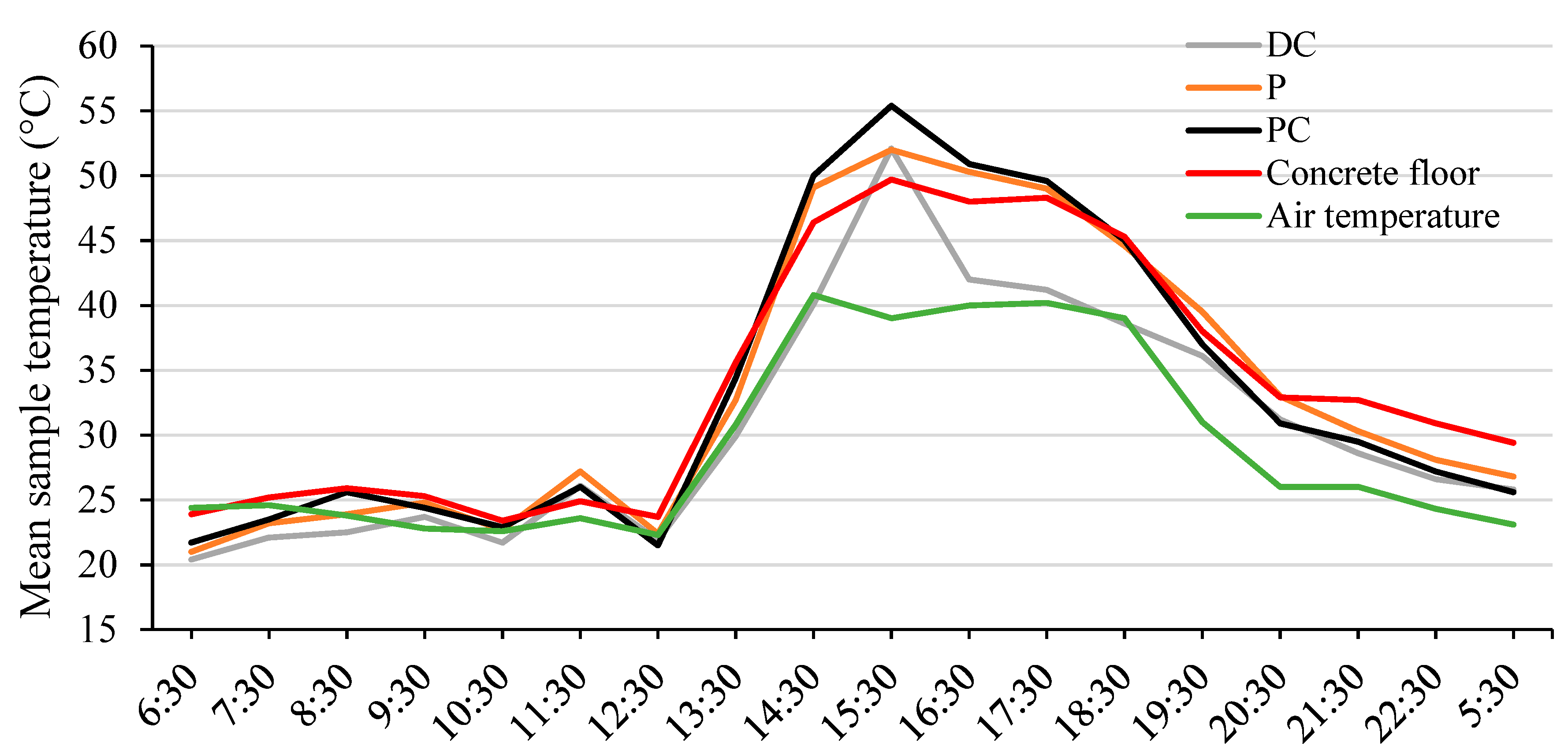
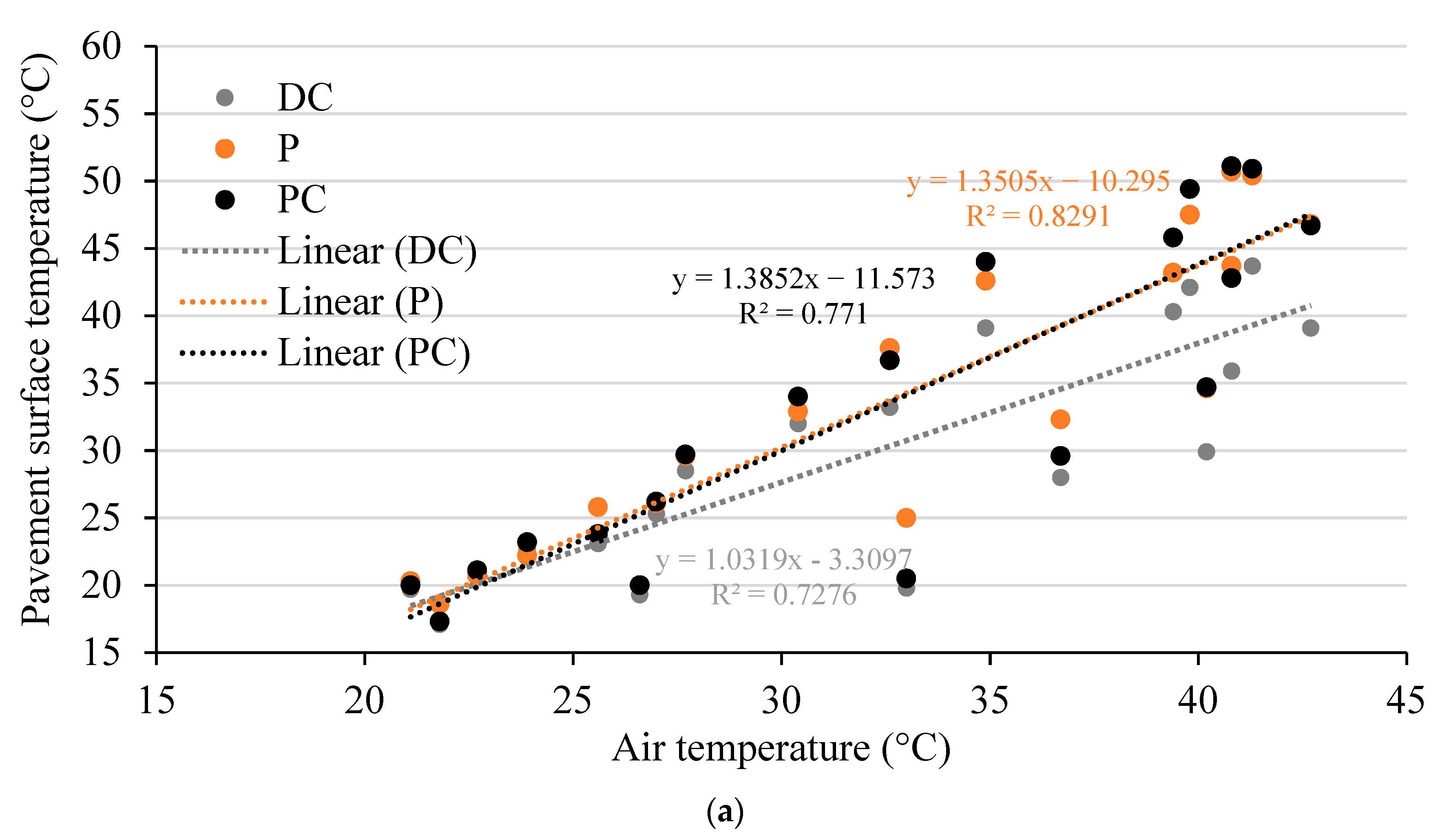
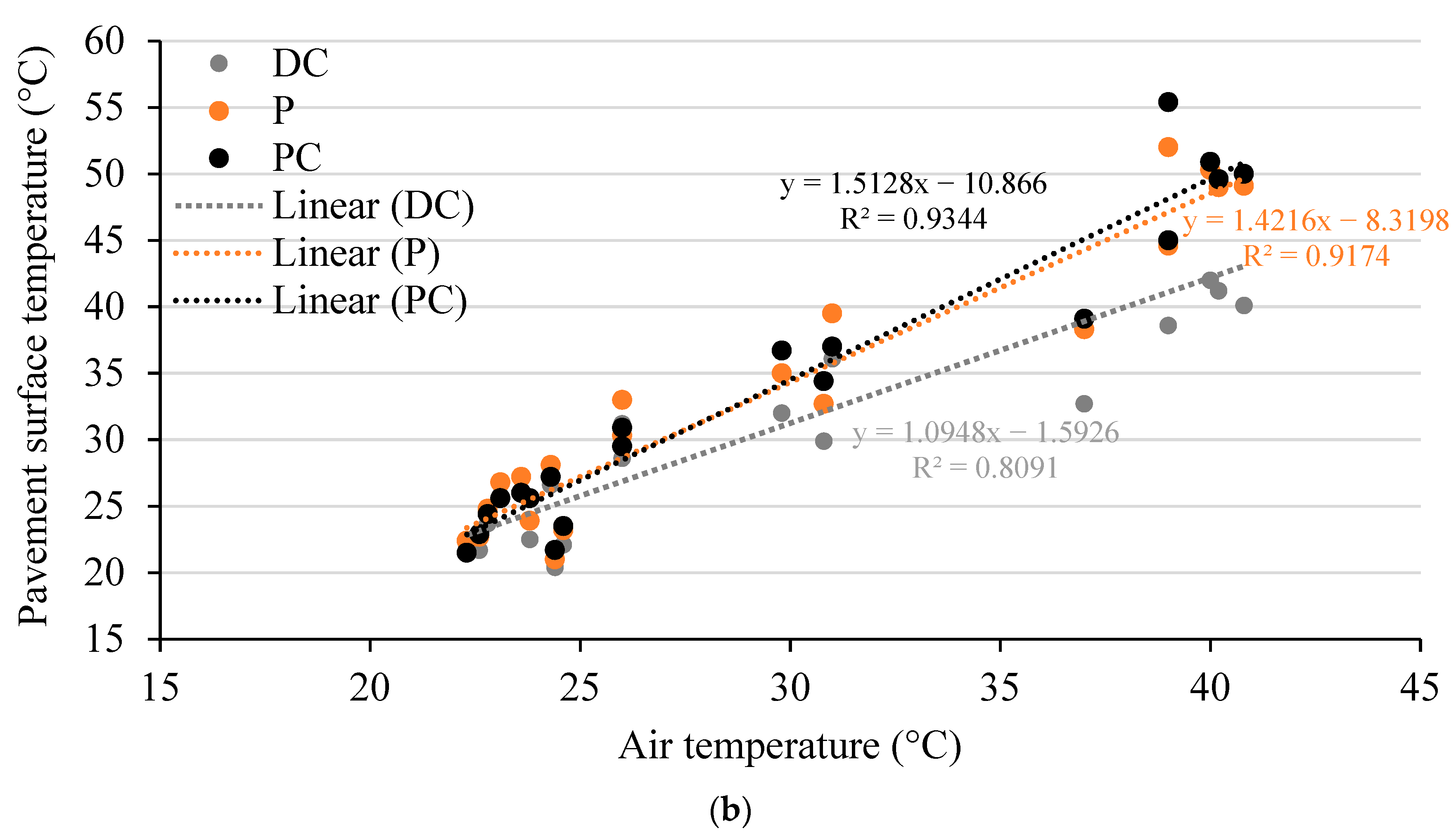
| CONCRETE SETUP | Time | Wind Direction | Wind [m/s] | Air Temperature [°C] | Relative Humidity [%] | GRASS SETUP | Time | Wind Direction | Wind [m/s] | Air Temperature [°C] | Relative Humidity [%] |
| 5:30 | NE | 1 | 24.4 | 87 | 6:00 | SW | 1.8 | 21.8 | 90.2 | ||
| 6:30 | NE | 1 | 24.6 | 85 | 7:00 | SW | 1.3 | 26.6 | 70.8 | ||
| 7:30 | E | 2.2 | 23.8 | 85 | 8:00 | NE | 0.6 | 33 | 57.3 | ||
| 8:30 | NW | 3.8 | 22.8 | 87.5 | 9:00 | S | 1.3 | 36.7 | 39.2 | ||
| 9:30 | NW | 3.1 | 22.6 | 88.6 | 10:00 | S | 2.4 | 40.2 | 41 | ||
| 10:30 | NW | 4.4 | 23.6 | 82.1 | 11:00 | SW | 2.3 | 40.8 | 33.8 | ||
| 11:30 | NW | 2 | 22.3 | 82.3 | 12:00 | SW | 4.1 | 42.7 | 29 | ||
| 12:30 | NW | 6.2 | 30.8 | 67.5 | 13:00 | W | 3.7 | 41.3 | 28.4 | ||
| 13:30 | NW | 6.3 | 29.8 | 64.2 | 14:00 | W | 3.2 | 40.8 | 32.8 | ||
| 14:30 | NW | 1.3 | 39 | 40 | 15:00 | W | 3.1 | 39.8 | 40.2 | ||
| 15:30 | E | 2.8 | 40 | 42 | 16:00 | NW | 2 | 39.4 | 35.2 | ||
| 16:30 | NE | 2.9 | 40.2 | 41 | 17:00 | NW | 1.4 | 34.9 | 41.6 | ||
| 17:30 | NE | 3.1 | 39 | 42 | 18:00 | NW | 1.2 | 32.6 | 50.6 | ||
| 18:30 | NE | 2.8 | 31 | 55 | 19:00 | NE | 1.2 | 30.4 | 56.5 | ||
| 19:30 | E | 6.2 | 26 | 75 | 20:00 | N | 0.8 | 27.7 | 65.3 | ||
| 20:30 | N | 1.5 | 26 | 72 | 21:00 | NE | 1.7 | 27 | 72.6 | ||
| 21:30 | NW | 0.9 | 24.3 | 73 | 22:00 | NW | 1.3 | 25.6 | 81.3 | ||
| 22:30 | NW | 1.8 | 23.1 | 80 | 0:00 | E | 0.5 | 23.9 | 86.7 |
| Average Surface Temperature of Sample (°C)/Base | DC | P | PC |
|---|---|---|---|
| Grass | 43.90 | 50.70 | 51.10 |
| Concrete | 52.00 | 52.10 | 55.40 |
| Temperature difference (°C) | 8.10 | 1.40 | 4.30 |
Publisher’s Note: MDPI stays neutral with regard to jurisdictional claims in published maps and institutional affiliations. |
© 2022 by the authors. Licensee MDPI, Basel, Switzerland. This article is an open access article distributed under the terms and conditions of the Creative Commons Attribution (CC BY) license (https://creativecommons.org/licenses/by/4.0/).
Share and Cite
Barišić, I.; Netinger Grubeša, I.; Krstić, H.; Kubica, D. Field and Laboratory Assessment of Different Concrete Paving Materials Thermal Behavior. Sustainability 2022, 14, 6638. https://doi.org/10.3390/su14116638
Barišić I, Netinger Grubeša I, Krstić H, Kubica D. Field and Laboratory Assessment of Different Concrete Paving Materials Thermal Behavior. Sustainability. 2022; 14(11):6638. https://doi.org/10.3390/su14116638
Chicago/Turabian StyleBarišić, Ivana, Ivanka Netinger Grubeša, Hrvoje Krstić, and Dalibor Kubica. 2022. "Field and Laboratory Assessment of Different Concrete Paving Materials Thermal Behavior" Sustainability 14, no. 11: 6638. https://doi.org/10.3390/su14116638
APA StyleBarišić, I., Netinger Grubeša, I., Krstić, H., & Kubica, D. (2022). Field and Laboratory Assessment of Different Concrete Paving Materials Thermal Behavior. Sustainability, 14(11), 6638. https://doi.org/10.3390/su14116638






